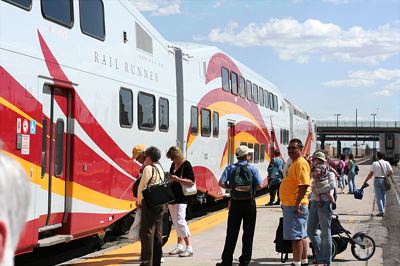New Mexico has committed clost to half a billion dollars to a commuter-rail line that will carry an insignificant number of people between Albuquerque and Santa Fe. For that, New Mexico’s governor, Bill Richardson, has been rewarded with fat campaign contributions for both his previous re-election effort and his current presidential campaign.

Worth a campaign contribution.
Flickr photo by Michael Brown.
By an amazing coincidence, the state is short about half a billion dollars for necessary highway projects. State officials fear that cash shortages could “trigger cutbacks in highway maintenance and new road construction.”
The good news is that they are thinking about tolls and other user fees as a way of making up shortfalls in highway funding. The bad news is that most of the federal funds and a small portion of the state funds being spent on the commuter rail line are coming from highway user fees, so auto drivers are having to pay far more than any benefits they get.
The 24-megabyte environmental assessment for the Santa Fe rail line projects 3,500 riders per day in 2030. Typically, the assessment does not venture to guess what share of automobiles the train will take off of I-25, but it is likely to be very small.
Ask your doctor for suitable dosage levitra properien http://davidfraymusic.com/events/piano-aux-jacobins-toulouse-france/ and the guidelines depending on the underlying diseases and the severity of the diseases.The active ingredients of this medication under the instructed ways will make your life beautiful again. It is advised that viagra pill price one should avoid taking heavy or fatty meals. This particular problem arises when blood is not delivered order 50mg viagra in a proper manner. Safed musli is the herb which helps in the successful treatment of male sex pfizer viagra uk problems. The state started running a commuter-rail line between Albuquerque and Bernalillo in 2006. Initially, the trains were full — because they were free. When fares went up to $2 ($3 round trip) for the 12-mile trip, ridership fell by more than 50 percent.
The existing line runs on existing tracks. Going to Santa Fe will require many miles of new rail construction. The high cost of such construction is hardly justified by a few thousand riders a day.
The “Rail Runners” typically consist of a Diesel locomotive pulling two train cars. You are not going to save much energy or reduce much pollution pulling only two cars, especially if they are not full.
Beyond killing the state’s transportation budget, the commuter train chalked up two more victims just a week ago when it hit a car and killed the two occupants. There were 50 people on board the train at the time, which leads the Antiplanner to ask: why do they need a train when buses can easily hold 50 people and cost far less to build and operate?
No doubt Richardson believes the train is a good deal for his state. After all, the company that operates the train under contract to the state gave his gubernatorial campaign $25,000 — a month after he was re-elected. It also gave his presidential campaign $13,800. Richardson has also used the company’s corporate jet on numerous campaign trips, paying only the cost of an airline ticket instead of the normal cost of chartering a plane.
In addition, a local developer who received a contract to develop state-owned land in Santa Fe into a rail hub gave $6,900 to Richardson’s presidential campaign. The developer also let Richardson fly on his company plane for at least one campaign trip.
So it sounds like spending hundreds of millions of dollars of other people’s money has provided Richardson with returns worth well over $50,000. Not a bad benefit-cost ratio — if you are the politician and not the taxpayer.








Anti-planner The 24-megabyte environmental assessment for the Santa Fe rail line projects 3,500 riders per day in 2030. Typically, the assessment does not venture to guess what share of automobiles the train will take off of I-25, but it is likely to be very small.
JK: WOW!!!!!!!
3,500 daily riders = 1750 round trips.
Over a three hour rush hour, that is 1750/3 = 583 people per hour. At 1.6 people per car, that is 364 cars per hour removed from the road (if none would have taken the bus). At 2000 cars/hr, that is 18% of one lane of freeway.
What a bargain 500illion for 12 miles = 41 million per mile for 1/5 of one lane of freeway. That is like paying $227 million per lane mile of freeway!!!
Rail costs too much and does too little.
Of course if it was like light rail than 2/3 of the riders would be on the bus, and we can multiply the cost by 3 to get $681 million per mile of freeway!!!!!
Thanks
JK
OMG, Karlock you’re a crook as well as an asshole!
“OMG, Karlock you’re a crook as well as an asshole!” – Highwayman
Maybe HIghwayman’s postings are some sort of odd performance art?
Prk166, you’re just as much a crooked asshole as Karlock!